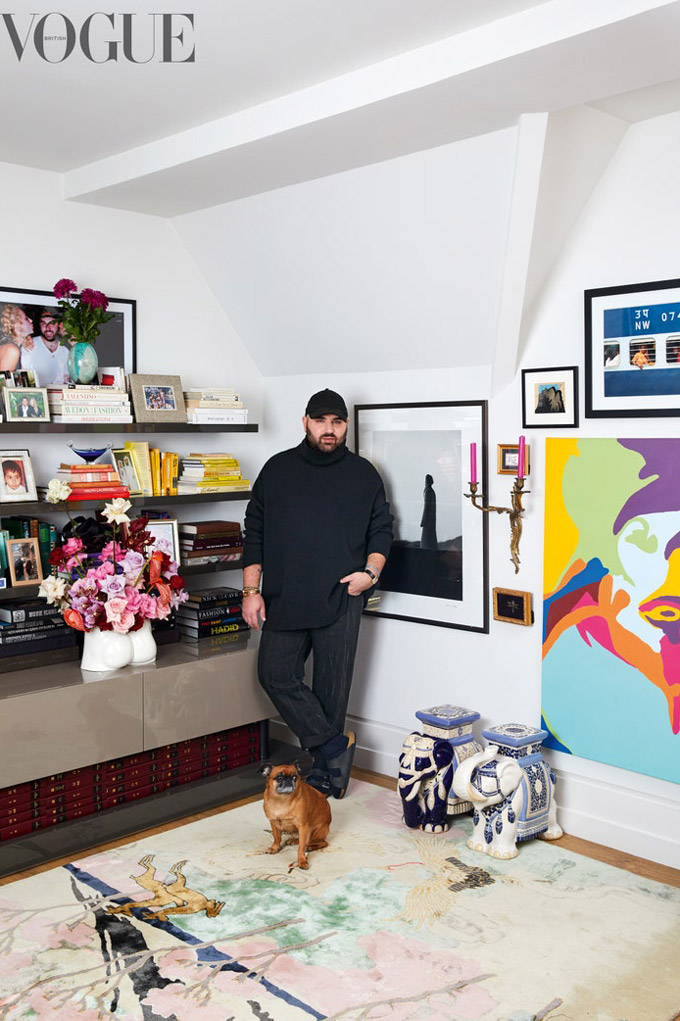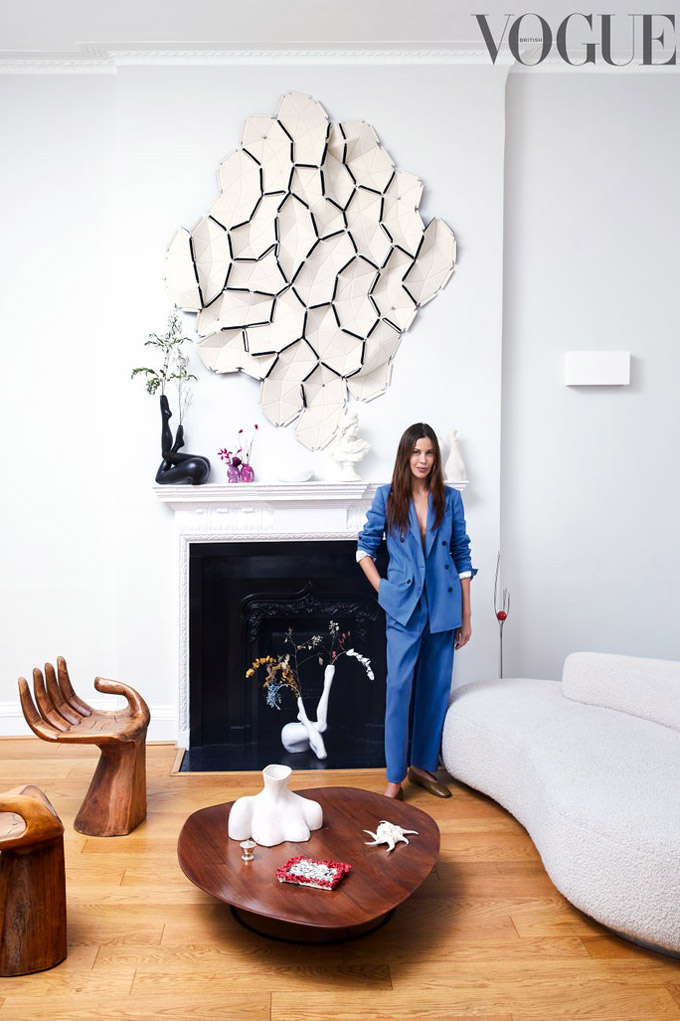Rejina Pyo
Fashion Designer
Rejina Pyo’s study is her sanctuary. “It’s such a luxury having a space all to myself that’s not the bedroom. It feels so grown-up,” says the designer of the small but perfectly formed retreat on the second floor of the Victorian terrace she shares with her husband and three-year-old son in north London. A reflection of the quiet, sculptural beauty of her namesake clothing label, it’s filled with books on Cy Twombly, hand-thrown pottery and a curation of designer finds. “I have a hard time buying new,” she says. “So I’m constantly setting Google alerts for my favourite designers.”
Pyo’s “dream desk”, by the Swedish architect Axel Einar Hjorth, was discovered quite by chance in a Tetbury antiques shop during a friend’s wedding weekend, while the mid-century Italian chairs by Mobil Girgi were a lucky online auction find. Her latest addition is a painterly vintage Berber rug from Larusi. Woven from wool and recycled women’s clothes, its palette of browns and oranges and yellows is wonderfully simpatico with Pyo’s own muted collections. A place for research and reflection, it’s here, among these treasures, that the designer has the headspace to sketch and create. “Every time I look out of the window at our garden of firs and palms,” she says, “I feel calm.”

Cyndia Harvey
Hairstylist
“I’ve never seen anything like this before.” When it came to decorating her south London home, this became Cyndia Harvey’s shopping mantra. Together with her interior designer pal Hollie Bowden, the hairstylist, who’s worked with musicians such as FKA Twigs and Frank Ocean, approached furniture buying much like art. “I wasn’t trying to match anything,” she says of the pair’s market trawls. “If it stood out and I liked it, I’d buy it.” This intuitive approach makes for a distinctive space that’s utterly her own.
Three years in, and the simple concrete-floored 1930s former stable block is accented by graphic monochrome prints from Jonathon Low antiques, oversize metalwork masks, huge cement Willy Guhl plant stands and—the pièce de résistance—a spectacular white fibreglass Splash chair picked up at Kempton Park. “Nothing in here is super-practical,” admits Harvey, who spends much of her time on her giant 1970s Heal’s beanbags. The only newness comes from a custom-made Donald Judd-inspired kitchen island. “His designs have a quiet simplicity that resonates with me,” she says. That same meditative mode drew her to the room, which opens on to its own brick courtyard: “It’s just so peaceful and hidden,” she says. “I connected to it straightaway.”

Michael Halpern
Fashion Designer
“It may look a bit bonkers, but to me it’s calming,” says Michael Halpern of the ever-evolving display of art, objets and blowsy florals that fills his sumptuous sitting room. The former office space, situated on the first floor of a shingle-clad building in a quiet Chelsea mews, is the perfect canvas for Halpern to play out his love of colour and collecting. The walls are hung with framed Uzbekistan kaftans, vibrant canvases by the Abu Dhabi artist Noor Al Suwaidi, such as “Serendipity” (2011), and an ad hoc array of imagery from artists and photographer friends, including a portrait by Tim Walker.
Even the floor tells a story: the cloud-strewn, champagne-hued, handwoven silk and wool rug by the Scottish maker Wendy Morrison, depicts frolicking tigers, deer and golden swans. “It’s so luxurious and impractical, which I love,” he says. Halpern has an emotional connection with every piece—from his own ceramics to the Singer sewing machine inherited from his great-grandfather, a tailor, which was lovingly restored by his engineer father as a graduation gift, or the cerulean blue 1970s Murano glass set—now used for brunch Bloody Marys—passed down by his mother on his 21st. Assembling these very personal pieces has helped anchor the New Yorker to his adopted hometown. “I need to be surrounded by lots of different layers,” he says. “That’s how I work in fashion, too. Mixing tone and texture and oddities together is my Zen.”

Anissa Kermiche
Jewellery Designer & Ceramicist
Chicly minimalist, Anissa Kermiche’s Marylebone living space is as close as you’ll get to Paris this side of the Eurostar. Lured by its airy, gallery-like looks, the French-Algerian creative moved into the open-plan apartment during lockdown, and is in the throes of making it “a little more cosy”, with a custom-conceived rug that’s inspired, naturally, by the female form. This imaginative, hands-on approach is typical of the engineer-turned-jeweller, whose provocative Love Handles vases are the cult ceramic of the Instagram age. Kermiche’s womanly weave will join an elite “members’ club” of high-low pieces that nod to her anatomical aesthetic. The mantelpiece is adorned with a modular Clouds piece by brothers Ronan and Erwan Bouroullec, painstakingly assembled by Kermiche.
The Parisian designers are also behind the low-slung coffee table—her first big investment piece—where, in a nod to her North African roots, she stages informal suppers. “I like things to be easy and unexpected,” says Kermiche, whose irreverent collection spans ear-embellished bowls (filled with her favourite Ambre-scented Bastide crystals), surrealist wooden hand chairs made in Bali, to a carved stone head—the only male in the house—picked up at the Sunbury Antiques Market at Kempton Park for £20. The atmosphere is luxuriantly simple. “I see so many colours and shapes at work, I need a room that’s soothing,” she explains. “The beauty of these objects makes me happy. This is my nest, where I can feel safe and serene.”

Naomi Smart
Shopping Director, British Vogue
While creating a nursery for her daughter, Penelope, in her east London home, rather than replicating the ubiquitous Scandi style, Vogue’s shopping director Naomi Smart tapped into her perennial obsession with the 1980s. “I just love the Crayola-bright colour palette,” says Smart, who followed the edict of the late design guru Terence Conran by starting with a backdrop of simple warm-white walls, which she then layered with bold eBay buys and clever, creative styling. To transform what had previously housed her expansive shoe collection, she began by painting the wood flooring an intense Picasso Blue by Valspar. The glass-topped bamboo and rattan console, now employed as a changing station, took many months of bleary-eyed night-feed scrolling to source. “I knew that I wanted things I’d be able to repurpose later elsewhere,” she says. “There’s nothing here I wouldn’t want in my own room.”
That also goes for the 1980s uplighter lamp and original Habitat mirror. Not that there aren’t some concessions to childhood, too. The Jules Verne hot-air balloon filled with Sylvanian Families characters nods to her father’s days as a balloon pilot; while the patchwork curtain fashioned from vintage silk scarves, some donated by family and friends, and others, like the original Balenciaga bloom, lucky online finds, was lovingly stitched together by Penelope’s paternal grandfather during lockdown. So what will baby Penelope think of this brilliant decorative mash-up? “She’ll probably end up being a minimalist,” jokes Smart. “But memories of your childhood bedroom never leave you, so I wanted hers to be as bright and exciting as possible.”
This story originally appeared on British Vogue.





